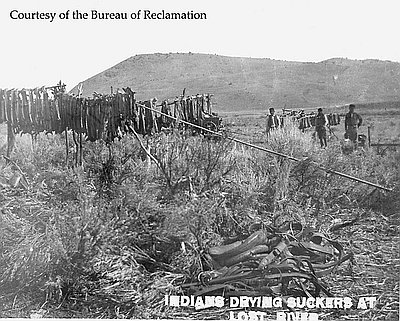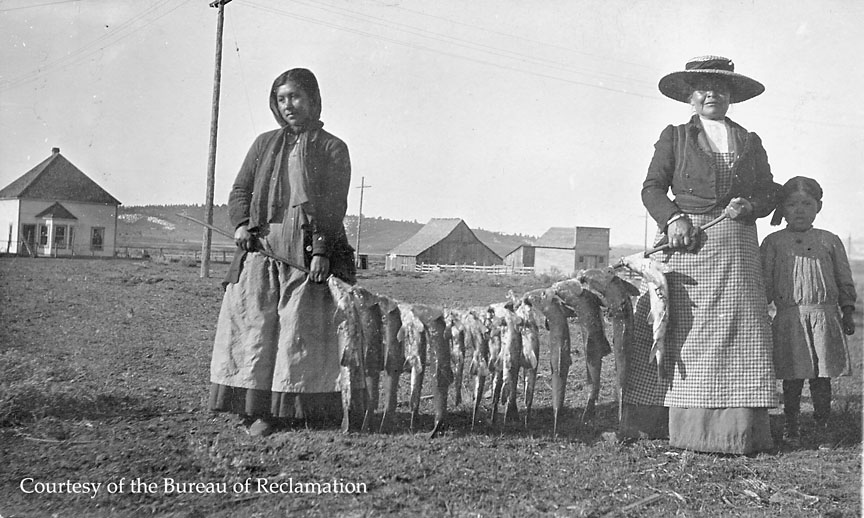- Catalog No. —
- KCM-7-145-2
- Date —
- 1905
- Era —
- 1881-1920 (Industrialization and Progressive Reform), 1921-1949 (Great Depression and World War II), 1950-1980 (New Economy, Civil Rights, and Environmentalism), 1981-Present (Recent Oregon History)
- Themes —
- Environment and Natural Resources, Native Americans
- Credits —
- Klamath County Museum
- Regions —
- Southwest
- Author —
- U.S. Bureau of Reclamation
Return of the C'wam
For thousands of years, the Lost River suckers and shortnose suckers have been important to the Klamath Indian culture and, more so than salmon, essential to their subsistence. In this photograph, Klamath women hold a string of suckers, illustrating their abundance in 1905. Early white settlers reportedly filled their wagons with suckers using pitchforks. In the last 60 to 80 years, however, unlimited fishing, low water levels, and poor water quality in the Klamath water system have threatened the existence of Lost River and shortnose suckers.
In 1979, Klamath tribesmen noticed declining sucker populations and contacted the Oregon Department of Fish and Wildlife. The agency denied there was a problem. Three years later, the Klamath Tribe hired a professional fishery biologist to study the sucker populations. In 1986, the tribe took their scientific data to the U.S. Department of Fish and Wildlife and initiated the suckers’ designation as endangered species (listed in 1988).
Recently, the Klamath Tribes have been criticized by farmers for supporting U.S. Bureau of Reclamation (BOR) water policies that benefit suckers. The BOR controls water flows from dams and canals, and decides, based on biological surveys, whether water levels meet the needs of the endangered suckers. When more water is needed to stabilize the suckers’ environment, less water is available to area farmers for irrigation. Dino Herrera, Director of Culture and Heritage for the Klamath Tribes, explains that they are working with government agencies to restore the wildlife habitat and improve the Klamath Basin water system. Above all, Herrera asserts, the tribe wants water for everyone. Today, the Klamath Tribes hold “Return of the Cwam” (Klamath language for the Lost River sucker, pronounced “cha-wam”) ceremonies, hoping for the return of their sacred fish.
Further Reading:
Foster, Doug. “Endangered Sucker Fish: The Klamath Tribes Struggle to Save a Native Fishery,” Southern Oregon Heritage 2, 1996: 30.
Written by Robert Donnelly, © Oregon Historical Society, 2003.
Related Historical Records
-
The Controversial Sucker
When author William Kittredge was a high school student in Klamath Falls, he and his friends caught suckers in Klamath Lake with unbaited hooks. “Somebody would hang a …
-
Sucker Harvest
For thousands of years, the Lost River suckers and shortnose suckers have been important to the Klamath Indian culture and essential to their subsistence. In 1983, the Klamath …

